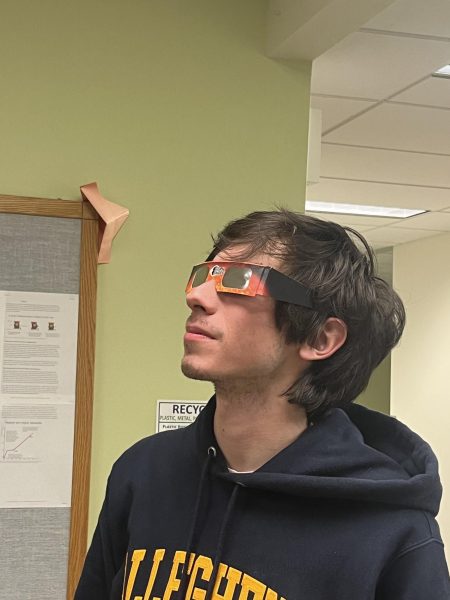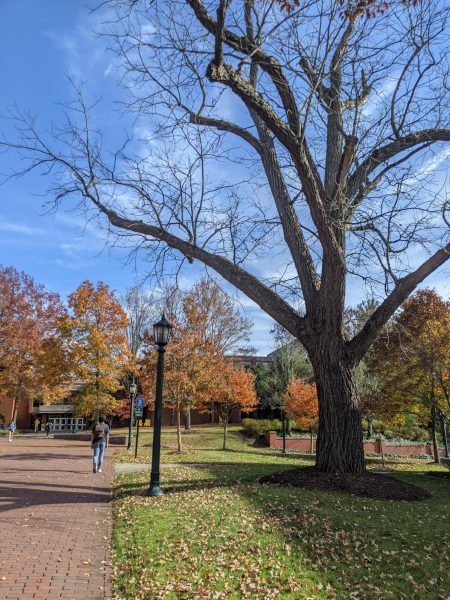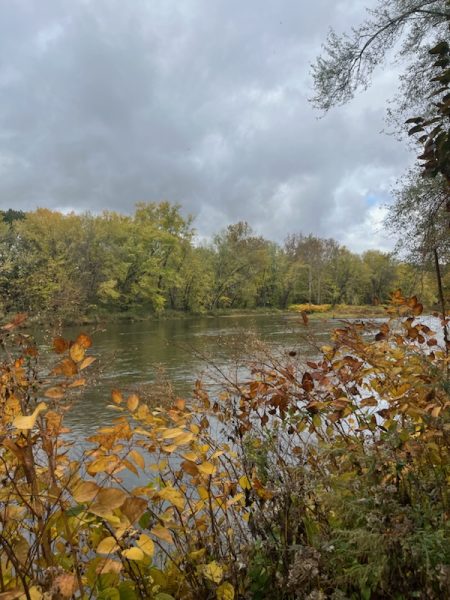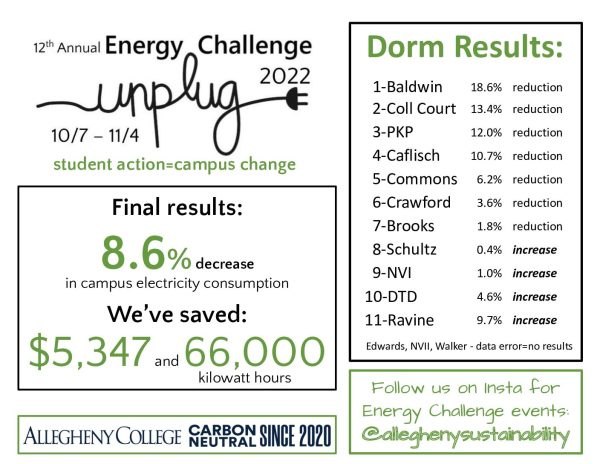Unitarian Universalists score solar panels with grant
The Unitarian Universalist Church in Meadville will now get most of its electricity from energy generated by the solar panels on its roof, thanks to the efforts of a small group of Allegheny students and faculty.
Sustainability is a central theme of the Unitarian Universalists’ religious tradition, according to current board member of the church and Professor Emeritus of Psychology Joshua Searle-White.
“We’re very concerned with the state of the world and the state of society and the state of relations between each other,” Searle-White said. “It seems like solar panels is an obvious way we can do something that both would be helpful for us as a church and also be a statement to the community that says, ‘Look, we think sustainability is really important.’”
Renewable energy is currently the cheapest form of power, according to the International Renewable Energy Agency. However, upfront installation costs can make it challenging for individuals and organizations to afford making the transition from fossil fuels to renewable energy; this was the limiting factor for the church.
The idea to install solar panels had been debated by the church’s boardmembers for a while, but was sidelined mainly due to its expense. When presented with the option to collaborate with Allegheny College to acquire the funds for the solar panels and install them, the church jumped at the opportunity.
Associate Professor of Environmental Science and Sustainability Ian Carbone spearheaded the entire project. Carbone said that the solar panels he and his class installed will cover approximately 80% of the church’s anticipated annual energy use and save the church money in the long run. Carbone knew for years that he wanted to do solar panel installations with students and underwent several training sessions to get the necessary professional certifications for solar design and installation. He also collaborated with community stakeholders during previous academic courses he taught in order to begin laying the groundwork for future projects.
In the fall of 2021, Carbone was awarded a small grant to teach ENERG 485: Applied Energy Analysis, a course focused on solar design. The class conducted an energy audit of the church and reached the unsurprising result that the church was not very energy-efficient due to its age. During the course, Carbone connected one of his students Joseph Pastorius, ’22, with the church’s board members. Pastorius then went on to design a solar plan for the building, which became the basis for the recent installation.
With Pastorius’s design, Carbone, Searle-White, the Allegheny grant office and Church President and Allegheny College Vice President for Information Services and Assessment Rick Holmgren applied for outside funding to install solar panels on the roof of the church and were awarded $44,750 from the Penelec Sustainable Energy Fund of the Community Foundation for the Alleghenies.
Carbone registered the solar panel installation project as an ENVSC 590 independent study and sent out an email to students in the Environmental Science and Sustainability department advertising the experience. Ariana Clark, ’23, saw the email and thought it sounded like an interesting opportunity.
“I always was intrigued by solar panels,” Clark said. “So I was like, ‘I want to do that. (I) don’t want to sit in a classroom. (It) sounds like a great cause.’ So I was like, ‘Why not?’”
Olivia Ave, ’24, chose to participate in the project because she felt it would be beneficial for the Meadville community.
“In a small community like Meadville, they don’t have a lot of opportunities for sustainable development just because economically it’s not the greatest at times,” Ave said. “When they’re given programs like this, they actually have the opportunity to look into more sustainable options and actually be able to learn more about climate change and how they can make a difference. I think it’s very important that we provide opportunities like this for small towns.”
When the fall 2022 semester rolled around, these students spent their Friday afternoons climbing up and down flights of stairs and in and out of windows to transport solar panels to the roof and install them.
The installation team worked through multiple issues, like occupation of the church and unexpected panel layout misfits.
“I’ve helped on solar installations, but this was my first time leading a solar installation,” Carbone said. “It was also my first time doing solar installation work with students, so the fact that it was new to so many involved meant there was problem-solving involved. What was really great about this bunch of students was they were engaged and smart and really willing to problem-solve and fix mistakes and figure out the best process as sort of a collaborative group.”
Clark described herself and her fellow students as Carbone’s “busy-bees,” saying that they would follow his direction while completing the tasks at their own pace. Clark appreciated the space the project provided for her to learn technical knowledge in a unique way.
“If you asked me what the process is, I could not tell you,” Clark said. “But if you gave me some materials of what we were doing, I could be like, ‘Oh, this connects here and this connects here, which sends electricity here.”
The electricity meter on the church is a net meter, meaning that it tracks how much energy the church consumes, as well as how much energy the church generates and sends back into the electrical grid. Over the summer months, the church will likely generate more energy than it consumes, according to Carbone. The excess energy will be sent into the electrical grid to be consumed by the church’s next door neighbors. The electrical company will take note of the excess energy the church sends into the grid and will give the church a proportionate discount on its winter energy bill, when the clouds and snow mean the solar panels will not produce as much energy.
“One of the big things about solar power is I never thought it was doable in Meadville, and it turns out it is,” Searle-White said. “It’s perfectly doable.”
After participating in the installation, Ave realized that she did not want to pursue a career in the physical installation of solar panels. However, the project affirmed her interest in sustainable development and her potential interest in helping to coordinate the logistics of similar projects.
Searle-White said projects like these are invaluable for undergraduate students because there is no substitute for going out into the world, seeing how things work and applying knowledge learned in the classroom with people in complex settings.
“My big revelation was when I watched (the students) talking about what it did,” Searle-White said. “I had tears in my eyes because it was like, ‘Wow, these people are really getting a vivid education here.’ It’s a memory they’ll carry with them, but also practical skills and also an appreciation of how you have to kind of — you’ve got your ideas and then you have to go and you have to kind of flex them with the realities.”
Carbone expressed similar sentiments to Searle-White and said that an additional important part of these types of projects is continuing to develop the relationship between the college and Meadville.
“What I hope is that this project provides an example of how a community can receive a service and students can receive an educational opportunity in a way that benefits both,” Carbone said.
In the future, Carbone plans to install another student-designed solar array for a local housing nonprofit called Common Roots on one of their low income rental properties.
Searle-White gave special thanks to Carbone for leading the charge on solar installation in Meadville.
“So much of this has to do with Ian’s willingness to think outside the box and willingness to kind of go the extra mile for students and for us too,” Searle-White said. “I think it shows what Allegheny students are capable of and it shows what Allegheny faculty are capable of. I think it’s great.”
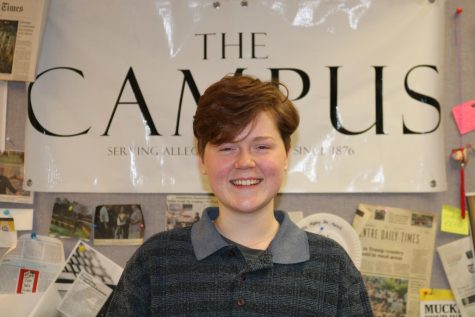
Anna Westbrook is a sophomore from Washington, D.C. They are majoring in Environmental Science and Sustainability with a double minor in Political Science...




